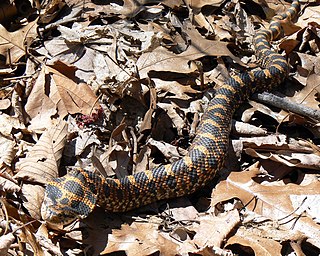
Cobra is the common name of various venomous snakes, most of which belong to the genus Naja.

Agkistrodon piscivorus is a species of venomous snake, a pit viper in the subfamily Crotalinae of the family Viperidae. It is one of the world's few semiaquatic vipers, and is native to the Southeastern United States. As an adult, it is large and capable of delivering a painful and potentially fatal bite. When threatened, it may respond by coiling its body and displaying its fangs. Individuals may bite when feeling threatened or being handled in any way. It tends to be found in or near water, particularly in slow-moving and shallow lakes, streams, and marshes. It is a capable swimmer, and like several species of snakes, is known to occasionally enter bays and estuaries and swim between barrier islands and the mainland.

The Gaboon viper, also called the Gaboon adder, is a viper species found in the rainforests and savannas of sub-Saharan Africa. Like all other vipers, it is venomous. It is the largest member of the genus Bitis, and has the longest fangs of any venomous snake – up to 2 inches (5 cm) in length – and the highest venom yield of any snake. No subspecies are recognized.

Russell's viper is a highly venomous snake in the family Viperidae native to South Asia. It was described in 1797 by George Shaw and Frederick Polydore Nodder. It is named after Patrick Russell and is one of the big four snakes in India.

Hognose snake is a common name for several unrelated species of snakes with upturned snouts, classified in two colubrid snake families and one pseudoxyrhophiid snake family.

The tiger snake is a large and highly venomous snake of southern Australia, including its coastal islands and Tasmania. These snakes are often observed and locally well known by their banding, black and yellow like a tiger, although the species can be highly variable in coloration and patterning. All populations are classified within the genus Notechis (Elapidae). Their diverse characteristics have been classified either as distinct species or by subspecies and regional variation.

Oxyrhopus petolarius, commonly known as the forest flame snake, is a species of mildly venomous snake in the family Colubridae. The species is endemic to Central and South America. There are three recognized subspecies.

The brown-banded water snake is a species of aquatic snake found in tropical South America and Trinidad and Tobago. It is also known as the water mapepire.

Bothrops alternatus is a highly venomous pit viper species found in South America. Within its range, it is an important cause of snakebite. The specific name, alternatus, which is Latin for "alternating", is apparently a reference to the staggered markings along the body. No subspecies are currently recognized.

The Indian cobra, also known commonly as the spectacled cobra, Asian cobra, or binocellate cobra, is a species of cobra, a venomous snake in the family Elapidae. The species is native to the Indian subcontinent, and is a member of the "big four" species that are responsible for the most snakebite cases in India.

Atheris squamigera is a venomous viper species endemic to west and central Africa. No subspecies are currently recognized.

Agkistrodon bilineatus is a highly venomous pit viper species found in Mexico and Central America as far south as Honduras.

The Natricinae are a subfamily of colubroid snakes, sometimes referred to as a family (Natricidae). The subfamily comprises 36 genera. Members include many very common snake species, such as the European grass snakes, and the North American water snakes and garter snakes. Some Old World members of the subfamily are known as keelbacks, because their dorsal scales exhibit strong keeling.

The Egyptian cobra is one of the most venomous species of snakes in North Africa, and has caused many snakebite incidents to humans. It averages roughly 1.4 metres (4.6

Goldie's tree cobra, also known commonly as the African tree cobra and as Gold's tree cobra, is a species of venomous tree cobra in the family Elapidae. The species is native to Central and Western Africa. This species is one of the two tree cobras in Africa, the other being the black tree cobra. Goldie's tree cobra is one of the most venomous snakes and creatures in Africa.

The forest cobra, also commonly called the black cobra and the black and white-lipped cobra, is a species of highly venomous snake in the family Elapidae. The species is native to Africa, mostly the central and western parts of the continent. It is the largest true cobra species with a record length of 3.2 metres.

Naja nigricincta is a species of spitting cobra in the genus Naja, belonging to the family Elapidae. The species is native to the deserts and drier regions of southern Africa. The species is largely nocturnal, and is often found while crossing roads at night. There are two recognized subspecies.

Oxyrhopus guibei is a species of snake in the family Colubridae. The species is endemic to South America. It is often called the false coral snake, but this common name can refer to any of a long list of other species, genera, and even entire families of snakes. Many nonvenomous snakes have evolved coloration that mimics that of venomous true coral snakes, a trait which helps them avoid predation.

Pseudoxenodontinae is a small subfamily of colubroid snakes, sometimes referred to as a family (Pseudoxenodontidae). They are found in southern and southeastern Asia, from northeast India to southern China and south into Indonesia as far east as Wallace's Line. There are 10 species in 2 genera. Most are very poorly known, such that Pseudoxenodontinae is one of the most poorly known groups of snakes.




















